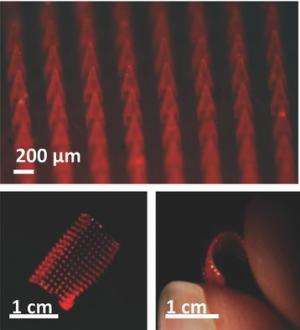Drug patch treatment sees new breakthrough

Wake Forest School of Biomedical Engineering has developed a flexible microneedle patch that allows drugs to be delivered directly and fully through the skin. The new patch can quicken drug delivery time while cutting waste, and can likely minimize side-effects in some cases, notable in vaccinations and cancer therapy.
News of the delivery technology was published in a recent issue of the scientific journal, Advanced Materials.
Leading development of the flexible patch was Lissett Bickford, now an assistant professor and researcher of biomedical engineering and the mechanical engineering, both part of the Virginia Tech College of Engineering. Work on the technology was completed while Bickford was a post-doctoral research associate at the University of North Carolina Chapel Hill.
Microneedle patch technology used on the skin has existed for several years, each patch containing an array of hundreds of micron-sized needles that pierce the skin and dissolve, delivering embedded therapeutics. However, because of their rigid chemical makeup, the patches proved difficult in fully piercing into the skin, creating a waste of drug material and a slowed delivery time. Additionally, the patches also have been difficult to produce in bulk; typical fabrication procedures have required centrifugation.
Bickford, with her research team, including Chapel Hill graduate student Katherine A. Moga, were able to develop a new flexible microneedle patch that forms to the skin directly – think a regular household bandage – and then fully pierces the skin and dissolves. Bickford said the softer, more malleable and water-soluble material also allows for more precise control over the shape, size, and composition of the patch, with little to no waste.
The nanoparticle, micro-molding patch is based on Particle Replication In Non-wetting Templates (PRINT for short) technology, developed by University of North Carolina researcher and professor Joseph DeSimone. Unlike other methods for making these patches, the new technology allows for quicker and greater wide-scale production, reducing related costs.
Journal information: Advanced Materials
Provided by Virginia Tech




















